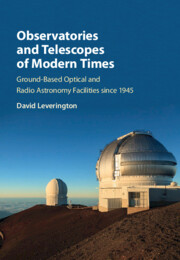 Observatories and Telescopes of Modern Times
Observatories and Telescopes of Modern Times from Part 1 - Optical Observatories
Published online by Cambridge University Press: 15 December 2016
An Advisory Committee on Astronomy had been set up by the Carnegie Institution of Washington in 1902 to report on the likely advances to be made in astronomy and how they could be supported.(1) Chaired by Edward C. Pickering, the director of the Harvard College Observatory, the committee recommended that an observatory should be set up in the southern hemisphere as there were, at that time, ten times as many observatories in the northern hemisphere as in the southern.(2) Although William Hussey of the Lick Observatory was given a small grant to undertake a site survey, nothing came of the idea of a southern observatory at that time.
The idea of a large new observatory in the southern hemisphere was resurrected by George Ellery Hale in the 1920s when he suggested that it should include a 100 inch (2.5 m) or 60 inch (1.5 m) telescope. He even suggested that if a new 60 inch could not be afforded then the current 60 inch at the Carnegie Institution's Mount Wilson Observatory should be relocated there. Walter Adams continued to push for a Carnegie southern observatory after he became director of the Mount Wilson Observatory in 1923. In 1931 Henry Norris Russell proposed that the southern observatory should have a 150 inch (3.8 m) telescope whilst three years later Adams suggested that it should be a 120 inch (3 m). But the collapse of the United States stock market in 1929, and the ensuing depression, meant that such proposals had to be put on ice.
The idea of a Carnegie southern observatory was reintroduced in 1962 when Merle Tuve, a director at the Carnegie Institution, asked Ira Bowen, Horace Babcock and Robert Leighton to outline long-range plans for the Institution's Mount Wilson Observatory. In response they produced a list of six major projects, one of which was the southern observatory. Separately Bowen suggested to Caryl Haskins, the president of the Carnegie Institution, that this observatory should include a 140 or 150 inch in order to compete with the telescopes planned in the southern hemisphere for the European Southern Observatory, the Anglo-Australian Observatory and AURA's Cerro Tololo Inter-American Observatory.
To save this book to your Kindle, first ensure [email protected] is added to your Approved Personal Document E-mail List under your Personal Document Settings on the Manage Your Content and Devices page of your Amazon account. Then enter the ‘name’ part of your Kindle email address below. Find out more about saving to your Kindle.
Note you can select to save to either the @free.kindle.com or @kindle.com variations. ‘@free.kindle.com’ emails are free but can only be saved to your device when it is connected to wi-fi. ‘@kindle.com’ emails can be delivered even when you are not connected to wi-fi, but note that service fees apply.
Find out more about the Kindle Personal Document Service.
To save content items to your account, please confirm that you agree to abide by our usage policies. If this is the first time you use this feature, you will be asked to authorise Cambridge Core to connect with your account. Find out more about saving content to Dropbox.
To save content items to your account, please confirm that you agree to abide by our usage policies. If this is the first time you use this feature, you will be asked to authorise Cambridge Core to connect with your account. Find out more about saving content to Google Drive.